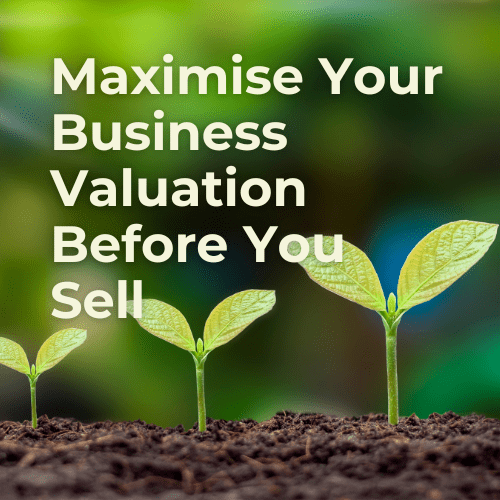
How to Maximise Your Business Valuation Before You Sell
Share
If you’re thinking about selling your business, or even if you’re just toying with the idea, there’s one question that needs to be front and centre: How do I maximise my business valuation?
🎙️ New Episode: How to Increase Your Business Valuation
Discover the levers that actually move your valuation multiple. In this episode of Built to Sell | Built to Buy, Sam breaks down the numbers, the metrics, and the mindset that will boost your business worth—whether you're planning to sell soon or just want to build a more valuable business.
Explore more episodes at sampenny.com/podcast
What is my Business Valuation? CLICK HERE
Too many business owners wait until the final year before sale to address the key drivers of valuation. By then, it’s often too late to meaningfully move the needle. But when you understand the numbers that drive your sale price, and take action early, you gain real control over the outcome.
This guide, based on Sam Penny’s "Built to Sell" webinar, breaks down exactly what buyers look for, the two levers that determine your valuation, and the 8 value drivers that can increase your multiple and final sale price.
The Simple Valuation Formula
At its core, your business valuation comes down to:
Valuation = Profit (EBITDA) × Multiple
The good news? You can influence both of these levers.
- EBITDA – This is your earnings before interest, taxes, depreciation, and amortisation. Essentially, it’s your true operational profit.
- Multiple – This is where most of the magic happens. Multiples are influenced by factors like industry, risk, scalability, and buyer confidence. The more desirable your business is, the higher your multiple.
What Buyers Are Really Buying
Buyers aren’t just buying your past performance, they’re buying future cashflow, confidence in your operations, and clarity around risks.
They want answers to questions like:
- Is revenue stable and predictable?
- Can the business scale without heavy owner involvement?
- Are systems and processes documented?
- Are financials clean and transparent?
Emotion might get attention. But numbers close the deal.
The 8 Value Drivers That Influence Your Sale Price
Here’s where you can really shift your valuation multiple. These eight areas are what buyers scrutinise during due diligence.
1. Financial Performance
Are you profitable? Is the profit growing? How does your margin compare to the industry average?
Buyers want to see a healthy, consistent EBITDA. Unexplained fluctuations are red flags. Your goal should be predictable and strong performance.
2. Growth Potential
What story do your numbers tell about the future?
A business with consistent year-on-year growth and a clear path to scale is far more valuable than one that’s flat. Map your total addressable market (TAM) and show that you’re only just scratching the surface.
3. Recurring Revenue
Nothing builds confidence like predictability. Buyers pay a premium for businesses with a high percentage of recurring revenue.
There’s a big difference between transactional, repeat, and contract-based income. A business with $500k profit and 80% recurring revenue is more attractive than one with the same profit but only 30% recurring.
4. Owner Independence
Here’s the harsh truth: the more your business relies on you, the less it’s worth.
Buyers want to know they can step in, or appoint someone else, and things won’t fall apart. Start removing yourself from daily operations. Track how many hours you’re actually needed each week. Replace yourself with systems, team roles, and documented processes.
5. Systems & Processes
Predictability equals value.
Standard Operating Procedures (SOPs), automation tools, and workflows all reduce reliance on individuals. Ask yourself: if you left for a month, would the business keep running?
Start documenting every repeatable task. This not only reduces transition risk but also increases operational efficiency.
6. Customer Concentration
If one customer accounts for 30% of your revenue, that’s a risk. What happens if they leave?
Ideally, no single customer should represent more than 15% of revenue. Diversifying your customer base strengthens buyer confidence.
7. Competitive Advantage
Can you justify premium pricing? Do you have something that competitors can’t easily copy?
Whether it’s a brand moat, proprietary tech, exclusive contracts, or market leadership, your edge matters. Buyers want to see proof that you can maintain (or grow) your market share.
8. Clean Books
Sloppy financials kill deals.
Make sure your P&L, balance sheet, and cashflow statements are clean and categorised. Buyers often request 3 years of historical data. Get an external accountant to review your reports and provide quality of earnings analysis if needed.
Real-World Example: Valuation Uplift
Let’s take a real case from the webinar.
eCommerce Company
- EBITDA: $250k
- Starting multiple: 2.6x
- Valuation: $650k
Valuation Drags:
- Low recurring revenue (<30%)
- Incomplete SOPs
- Short trading history
Actions Taken:
- Introduced loyalty program and subscription model = 0.3x uplift
- Documented onboarding playbooks and SOPs = 0.2x uplift
- Waited 12 months and maintained clean accounts = 0.2x uplift
New Multiple: 3.3x
New Valuation: $825k
Increase: 27% ($175k)
Presentation Matters: How to Package Your Business for Sale
Your numbers might be great, but if you don’t present them well, buyers won’t see the value.
Here’s what they want:
- Clean 3-year P&L
- Accurate balance sheet
- Monthly revenue trends
- SOP documentation pack
Think of this like a pitch deck. Make it easy for buyers to say yes.
What to Fix First: Actionable Next Steps
You don’t need to fix everything at once. Start with:
- Completing the Business Readiness Report: sampenny.com/readiness
- Identifying your top 3 valuation drags
- Implementing 3 quick wins that boost buyer confidence
Need help identifying what’s holding your business back? The Business Valuation Report will show you where you stand today, and how to increase your value before you sell.
You’re Not Just Selling a Business - You’re Selling Confidence
The businesses that command the highest multiples aren’t necessarily the biggest, they’re the ones that feel the safest and most scalable.
If you want to maximise your valuation:
- Know what to measure.
- Know how to improve it.
- Know how to present it.
Start today. Don’t wait until you’re ready to sell. Build a business that buyers chase.
For a deeper dive, watch the full video: "Built to Sell | The Numbers That Drive Your Sale Price" with Sam Penny.
👉 Subscribe to the channel for more episodes on business sale readiness, valuation strategy, and exit planning.
And if you're serious about increasing your business value, book your Exit Strategy Call at sampenny.com/strategy.
Related Reads
- 7 Proven Strategies to Maximise Business Valuation
- What Is My Business Worth? How to Get a Realistic Valuation (Without the BS)
- How to Sell a Business in Australia: The Step-by-Step Owner's Guide
- Don’t Buy a Business Without This: The Investor’s Business for Sale Checklist
- Business Brokers in Australia: How to Find the Right One for Your Business for Sale Deal


